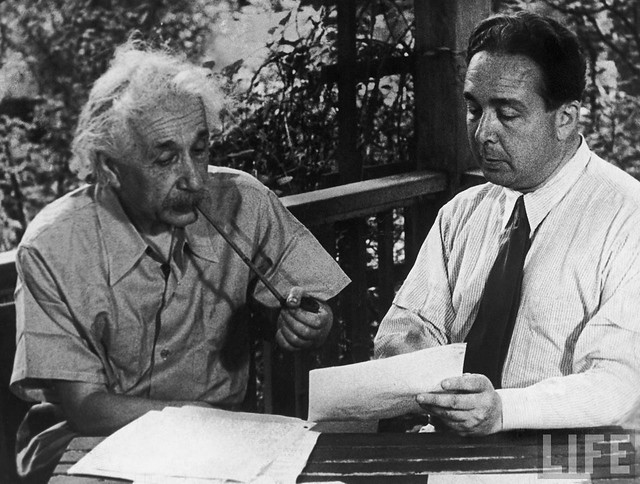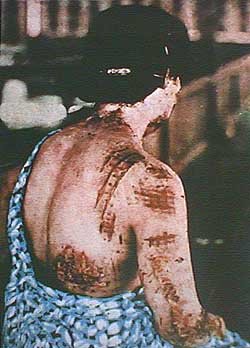Scientists and the Bomb: ‘the Destroyer of Worlds’
On August 6, 1945, the United States dropped a nuclear weapon on Hiroshima, Japan – the first time such a catastrophic weapon was ever used in conflict. Three days later the U.S. released another on Nagasaki, devastating the city and ushering in the nuclear age. Over the next few weeks, Global Zero will explore what led to the bomb’s development, the consequences of its use, and where we’ve come since those fateful days in August. This is the fourth post in our series “‘My God What Have We Done:’ The Legacy of Hiroshima and Nagasaki.”
With a blast four times bigger than estimated, the Trinity Test of July 1945 offered the first real glimpse at the overwhelming destruction of one atom bomb. For many scientists, the excitement of discovery in nuclear technology was clouded by the realization of how their achievements would be used by the military. The truth was the Manhattan Project was a program of war. Some of the best scientific minds of the era developed a weapon of mass destruction that could flatten a city and kill tens of thousands of civilians in minutes.
On June 11, 1945, one month before Trinity, scientists at the University of Chicago’s Metallurgical Laboratory issued the Franck Report, which argued against using the bomb on Japan. “If the United States would be the first to release this new means of indiscriminate destruction upon mankind,” the report argued, “she would sacrifice public support throughout the world, precipitate the race of armaments, and prejudice the possibility of reaching an international agreement on the future control of such weapons.” The report recommended an early demonstration of the bomb’s power on an uninhabited area, a recommendation rejected by decision-makers.
J. Robert OppenheimerI remembered the line from the Hindu scripture the Bhagavad Gita...‘Now I am become Death, the destroyer of worlds.’
Leo Szilárd, a committee member of the Franck Report and the physicist whose idea would eventually lead to the development of the atomic bomb, was a pacifist. After various efforts to share his concerns about the moral and geopolitical implications of the bomb’s use to U.S. President Harry Truman, Szilárd drafted a petition arguing against its use on Japan. The final language, which had been watered down from a full-hearted proposal that the bomb’s use be avoided altogether, argued its use on Japan “could not be justified” until the consequences of its use were made clear to Japan and they were given a chance to surrender. While collecting signatures on such a secretive project proved difficult, as some military authorities claimed it was a security risk, the petition still garnered 70 signatures.
Katherine Way, one of the leading scientists of the Manhattan Project and signer of the Szilárd petition, also wrestled with the bomb’s use before the successful Trinity Test. Her concerns continued after the war. In 1946, she co-edited One World of None: A Report to the Public on the Full Meaning of the Atomic Bomb – a compilation of essays from prominent atomic scientists, including Albert Einstein and J. Robert Oppenheimer, highlighting thoughts and concerns over the implications of the new nuclear age.

In 1944, Joseph Rotblat was working as a physicist working at Los Alamos when he heard the Germans had suspended their nuclear weapons program. His rationale for working on the project gone, Rotblat became the only scientist to leave the Manhattan Project. Years later, committed to preventing another Hiroshima and Nagasaki, he played a key role in issuing the Russell-Einstein Manifesto, which argued nuclear weapons “threaten the continued existence of mankind” and urged all governments to “find peaceful means for the settlement of all matters of dispute.”
One of the most famous examples of Manhattan Project scientists’ moral conflicts is J. Robert Oppenheimer’s invocation of lines from the Bhagavad Gita to describe the reaction to the Trinity Test:
“We knew the world would not be the same. A few people laughed, a few people cried, most people were silent. I remembered the line from the Hindu scripture the Bhagavad Gita. Vishnu is trying to persuade the prince that he should do his duty and, to impress him, takes on his multi-armed form and says ‘Now I am become Death, the destroyer of worlds.’ I supposed we all felt that, one way or another.”
While his words echo through history as a reminder of the devastation and consequences of nuclear weapons, Oppenheimer was far from a pacifist. Known to some as the “father” of the atomic bomb, he sat on the Scientific Panel of the Interim Committee, a high-level committee providing recommendations on issues regarding nuclear technology. In a report to the Committee, the panel wrote that they saw “no acceptable alternative to direct military use” of the bomb against Japan. And when it came to the nuclear bombings, Oppenheimer claimed to carry “no weight on [his] conscience.” In his view, scientists were separated from the issues over the military use of the bomb. Those problems were for governments, not scientists.
This separation did not shelter Oppenheimer from ethical struggles, nor prevent him from understanding the true meaning of the bomb’s development. Two years after Trinity, Oppenheimer told physicists the bomb “dramatized mercilessly the inhumanity and evil of modern war.” He went on to note “the physicists have known sin; and this is a knowledge they cannot lose.”

For some, questions over the military use of nuclear weapons came later when images of the aftermath of the bombings of Hiroshima and Nagasaki brought the horrific consequences into real life. Robert Christy, a Manhattan Project physicist, described their impact: “I’d seen pictures of Hiroshima, of people who suffered very severe burns with flesh hanging in shreds from their arms. […] You don’t think about those things when you’re working on it. You think about solving the immediate problems.”
After World War II, a number of scientists like Rotblat dedicated their work to preventing the spread of nuclear weapons and protecting against their use. Manhattan Project scientists went on to found the Federation of American Scientists and the Bulletin of the Atomic Scientists whose Doomsday Clock has become a notable marker for how close humanity is to destruction by our own hands.
While some Manhattan Project workers grappled with moral dilemmas, the U.S. government pushed forward with plans to bomb Japan. Concerns and objections to the bomb’s use were dismissed or ignored – the train had left the station. Our next post lays out how the U.S. decided on Hiroshima and Nagasaki as targets for the first nuclear bombings.